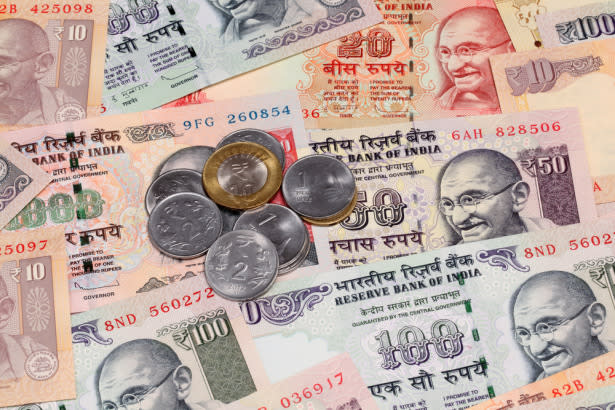- January 31, 2023
- Posted by: Amit Pabari
- Category: Uncategorized

The Economic Times | Markets
A movement from 83 to 81 finally justified the rupee’s strength versus the dollar. After remaining deviated for more than a month, finally in the new year, rupee chased its peers and started taking cues from the weaker USD.
Standing right at multi-days or a week or a couple of months high, one must be eager to know the outlook from hereon.
So, over the short to medium term, the Indian rupee is about to follow its own financial alphabetical order. For now, let’s keep the first alphabet A aside, and check out the next in the orders.
A- ???
B- Budget (populist vs reformist)
C- Central banker’s meeting (US, BoE, ECB, RBI)
D- Deficit (trade and Current account)
E- Economic data (US and India)
F- Flow story (FII vs FDI)
B for Budget:
A truncated week and a couple of days left for a final budget in front of the current government before the 2024 election. The market expects the government to continue with a higher fiscal deficit of approx.
5.9% of GDP for FY 24 vs 6.4% for FY23. The budget could tilt more towards a Populist one with a focus on capex, growth, and gross G-sec borrowing figure near Rs 16-16.5 trillion.
In any chance, if the budget comes up with higher borrowing or sets a higher fiscal deficit target then in knee jerk reaction rupee could depreciate.
However, the most chattered topics- announcement of bond inclusion, favorable changes in short- or long-term capital gain tax, or relaxation in 80C will trigger a positive movement in the rupee.
C for Central banker’s meeting:
The central banker’s meeting in the first and second week of February could spur volatility in the forex market. The interesting observation in these meetings would be the size of the hike.
Considering a gap between inflation and interest rates then the US Fed has a gap of 2% and is thus expected to go with a smaller hike of 25 bps.
Whereas ECB and BoE are having more than a 6.5% gap, and thus they still have a long way to go or keep on hiking rates. Overall, meetings would be bearish for USD and bullish for EUR & GBP.
In the case of RBI, they may walk the extra mile of 25 bps despite having a positive real yield and thus sends a positive directional cue for rupee.
D for Deficit:
What matters to the rupee is trade and current account deficit. Just brushing up, a higher deficit requires a higher amount of dollars and increases demand for the same and decreases the value of the rupee.
A fall in the trade deficit from $30 billion to $23 billion a month, and expectation of ease in the current account deficit (CAD) in FY24 majorly on account of the fall in global energy prices will help rupee to gain its value.
E for Economic Data:
The economic data are the barometer for the health of the economy, and it helps central bankers to take a call on their monetary policy stance.
Broadly, US data except job reports are not promising. Be it PMIs or inflation or housing or consumer/business survey, all are unfavorable for USD. On another front, data from Europe and the UK are in a recovery mode.
If we discuss India’s economic data, then PMIs, inflation, IIP, and trade deficit all are constructive. Thus, traders will keep on setting a long carry based on fundamentals and that will be rupee positive.
F for Flows:
Flows could be evaluated from 2 angles – short-term or hot flows, that is FII and long term or permanent flows, that is FDI.
Currently, FIIs are in a withdrawal mode with Rs 15,000 crore of outflow in January, which may be due to a few reasons – China reopening, switching from overvalued Indian stocks to other global undervalued stocks, or may be due to profit bookings ahead of Budget.
However, Adani’s FPO flows worth Rs 20,000 crore, which is kicking off from 27th Jan could attract some FPIs to invest in the secondary market.
That apart, it was heard on the street that the HDFC NSE 1.71 % and HDFC Bank NSE 1.75 % merger could attract $6 billion in inflows through MSCI rebalancing.
On another side, FDI flows emerged out of thin air and suddenly a bundle of flows started hitting the pair. To name a few, the SBI NSE -0.35 % infrastructure bond worth Rs 10,000 crore and RBI’s green bond (Rs 8,000 crore each in Jan and Feb) supported well to the rupee.
Furthermore, after EXIM’s successful borrowing of $1 billion via a 10-year bond, now REC NSE -0.86 % is expected to raise funds via a dollar-denominated bond.
Yes, some flows based on expectations already hit and some are yet to arrive. On a net basis, FII flows are expected to turn positive, whereas FDI flows are already supporting the rupee’s move.
Technically speaking:
The pair is on the verge of a breakdown below 81. If it closes below this, then it can be seen moving toward the next support zone of 80-80.50 levels, where the pair resisted from July to Aug 2022.
Further, the breach of the neckline at Rs 81 confirms the ‘head and shoulder’ pattern breakdown, which sets a target of at least 80 to 79.50 over the medium term. Yes, RBI’s intervention could slow down the pace of a fall but below 80 levels cannot be ruled out.
Outlook:
Are we forgetting anything to discuss? Oh yes! We are yet to answer the first alphabet-A. Based on the given discussion on the Budget, central bank meeting, deficit, economic data, and flow story, one can judge that Rupee is likely to appreciate (A) against the USD. And this ‘A’ completes the given alphabetical order of rupee.
Overall, the bias-ness of the pair is likely to remain bearish with the potential to move towards 80.80 to 80.50 over the short term (15 days) and 80 to 79.50 over the medium term (up to 1.5 months). On the flip side, the 81.75-82.00 zone is likely to be resisted over the short term.
–Amit Pabari is the MD, CR Forex Advisors. The views expressed in this article is his personal views.
Source: https://tinyurl.com/53ur5w77




